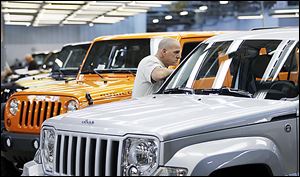
GUEST COLUMN
Despite what GOP says, auto bailout worked
10/31/2012
A worker looks over a Liberty at Chrysler's Toledo assembly complex this year.
With Ohio poised to determine who wins the election, President Obama’s rescue of the automobile industry remains a white-hot issue.
That’s hardly surprising, because almost 850,000 Ohio jobs depend on that industry — and 80 of Ohio’s 88 counties have manufacturing facilities related to autos.
Those who supported the President’s action (including Ohio Sen. Sherrod Brown) say it not only worked, but also is a major reason that Ohio’s unemployment rate — now 7 percent — is lower than it’s been since 2008.
Those who did not support the rescue (including Mitt Romney, Ohio Senate candidate Josh Mandel, and Gov. John Kasich) downplay its significance, understate the number of jobs saved or created, and argue that private capital — not federal funds — should have been used to finance the necessary restructuring.
So who’s right?
The good news is that unlike so many “he said, they said” campaign claims — which leave average voters scratching their heads and trying to decipher who’s telling the truth — the auto rescue facts are clear and unambiguous. The President was right. His critics were wrong.
Let’s start with jobs. In the spring, Governor Kasich claimed the rescue was responsible for creating only 1,800 direct jobs. A few weeks ago, Mr. Kasich went even further — with the preposterous claim that Ohio is losing auto-industry jobs.
In making these arguments, the governor uses two statistical sleights of hand. To reach the 1,800 job number, he starts counting jobs in January, 2011, when he took office — and inexplicably stops counting in September, 2011, just nine months later.
But 110,000 Ohioans were employed in the auto industry before the onset of the Great Recession in late 2008. By June, 2009, 40,000 of those jobs were gone.
Then the Obama Administration auto rescue kicked in. According to the Bureau of Labor Statistics’ Quarterly Census of Employment and Wages, nearly 12,500 Ohio auto employees went back to work in the 27 months between June, 2009, and September, 2011.
In the six months that followed, an additional 5,000 jobs were created, bringing the total to more than 17,300 since the auto rescue began.
So how can Mr. Kasich claim Ohio is losing jobs? By (a) switching to statistics drawn from a different (and less comprehensive) Bureau of Labor Statistics data set, one in which only a sample of employers offers estimates of monthly employment across different industries; and (b) continuing to count only those jobs created between January and September, 2011.
Instead of using the bureau’s quarterly census — which surveys nearly all employers and reports actual job numbers — the governor arbitrarily limits the time frame and uses statistics derived from monthly guesses by a relative handful of companies.
Of course, if Mr. Kasich were to use the more comprehensive labor bureau data, the numbers wouldn’t support his narrative. So he’s opted to sacrifice truth on the altar of political expediency.
Which brings us to Mr. Romney’s assertion that the auto industry should have gone through formal bankruptcy proceedings and used private capital — rather than government funds — to continue operations.
Nice theory, but one completely divorced from reality in 2009 at the height of the Great Recession.
As former General Motors vice chairman Bob Lutz recently told the Columbus Dispatch: “Of course we went to the banks to see about refinancing. The banks said, ‘Don’t look at us. We’re broke, too.’ Everybody forgets that.”
Chrysler’s current chief executive officer, Sergio Marchionne, likewise said it “would have been impossible” to do an orderly bankruptcy with private money. “Nobody would have bet a dollar on our survival,” he said.
Hedge funds — including Bain Capital, Mr. Romney’s old firm — also were approached and asked to invest. None was willing.
Even automakers that got no direct benefit — including Honda, Ford, and Toyota — either did not oppose the rescue or supported it outright.
As Honda’s chief lobbyist told the Dispatch: “There is an integrated supply chain in this industry.” Without the rescue, our suppliers “would have had a very difficult time maintaining our operations … It would have had a devastating impact on a lot of them.”
The bottom line is that the President’s auto rescue plan worked. The industry was saved. Ohio’s economy was resuscitated. Taxpayer loans have been repaid. A reborn GM replaced Toyota in 2011 as the world’s No. 1 automaker, and remains globally competitive.
Ohio voters want facts, not spin. If Mr. Romney, Mr. Mandel, and Governor Kasich had gotten their way, neither America nor Ohio would have an auto industry today.
Janetta King is president of Innovation Ohio, and Tom Perriello is CEO of the CAP Action Fund in Washington, D.C. This essay originally appeared in the Cleveland Plain Dealer.